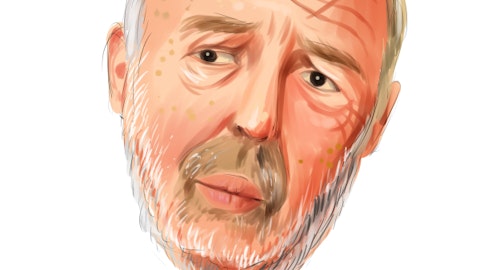Coterra Energy Inc. (NYSE:CTRA) Q3 2023 Earnings Call Transcript November 7, 2023
Operator: Ladies and gentlemen, thank you for standing by. My name is Cheryl and I will be your conference operator today. At this time, I would like to welcome everyone to the Coterra Energy 3Q ‘23 Earnings Conference Call. [Operator Instructions] Thank you. I would now like to turn the call over to Dan Guffey, Vice President of Finance, Planning and Investor Relations. Please go ahead.
Dan Guffey: Thank you, operator. Good morning and thank you for joining Coterra Energy’s third quarter 2023 earnings conference call. Today’s prepared remarks will include an overview from Tom Jorden, Chairman, CEO and President; Shane Young, Executive Vice President and CFO; and Blake Sirgo, Senior Vice President of Operations. Following our prepared remarks, we will take your questions during our Q&A session. As a reminder, on today’s call, we will make forward-looking statements based on our current expectations. Additionally, some of our comments will reference non-GAAP financial measures. Forward-looking statements and other disclaimers as well as reconciliations to the most directly comparable GAAP financial measures were prepared in our earnings release and updated investor presentation. Both of which can be found on our website. With that, I’ll turn the call over to Tom.
Tom Jorden: Thank you, Dan and thank you all for joining us this morning. Coterra had an excellent third quarter, exceeding expectations across the board. This was the result of several factors, including outstanding performance from our top-tier assets and excellent operational performance from our organization. I want to particularly acknowledge our field employees and vendors, who are the driving force behind our outstanding results. Although we are pleased to announce these results, quite frankly, it’s what you should expect at Coterra and what we expect of ourselves. We are not interested in being average. These results are best understood within the framework of the core thesis of Coterra. With top-tier oil and natural gas assets, Coterra can flexibly allocate capital to take advantage of changing commodity prices, changing technical innovations and changing field conditions.
We work for our shareholders and we believe that they are best served by a disciplined approach that generates consistent, profitable growth. We do not manage the company around production targets. We manage the company to maximize the financial productivity of our assets. We seek to grow our per share profitability throughout the cycles, which is best achieved through a combination of prudent investments and direct shareholder returns, in the form of dividends and buybacks. We are problem solvers. Albert Einstein said, “It’s not that I am so smart. It’s just that I stay with problems longer.” At Coterra, we stay with problems longer. Staying with problems longer means that we do not simply adopt workable solutions. We demand perseverance in finding optimum solutions.
This is true with our technical challenges as well as our financial challenges. We do not adopt an A-priority, zero-growth posture and operational planning. No more or no less than we assume A-priority answers to technical problems before engaging in rigorous analysis. A key focus of our organization is iterative, operational and financial planning. We engaged in exhaustive planning iterations in an ongoing effort to maximize our capital efficiency, focusing both on asset productivity and cost optimization, which also allows us to analyze and model multiple options. Dwight Eisenhower said that, “in preparing for battle, I have always found that plans are useless, but planning is indispensable.” At Coterra, we build annual capital plans that have on-ramps and off-ramps.
By limiting our long-term commitments, we retained the option to pivot capital from one area to another as conditions warrant. Our history tells us that flexibility is crucial or we cannot predict the future. And it’s not the plans that are important, it is the planning. This planning process, combined with the high energy, innovative and curious organization is the core of Coterra’s strength. We do not intend to provide detail on our 2024 plans during this call. However, we are highly confident that our results will continue to be top tier, that our capital efficiency will continue to improve and that the quality and duration of our inventory will continue to be apparent. As we have previously discussed, we expect to enter the year holding our Marcellus gas production relatively flat as we monitor gas macro conditions.
By doing so, we can reduce Marcellus’ capital by at least $200 million versus 2023, while maintaining the optionality to pivot back to the Marcellus when gas markets structurally rebound. In February, we will provide an updated 3-year outlook. We do not expect significant deviations from our current strategy of allocating capital to its most productive use to achieve moderate disciplined growth. Under a moderate multiyear growth strategy, our corporate breakeven defined as the ability to generate excess free cash flow after paying our healthy common dividend, will remain below $50 oil and $2.50 natural gas. Before I turn the call over to Shane, I want to close with our answer to the question, why Coterra? Coterra is a new company and one that is unique in our space.
We have top-tier assets, a top-performing organization and robust revenue diversity. We operate among a field of great competitors, and we are here to compete. Coterra is designed to provide excellent financial and operational results through the cycles. Our goal is to make top-tier results routine. As I said, it is what you should expect of us because it’s what we expect of ourselves. With that, I will turn the call over to Shane.
Shane Young: Thank you, Tom and thank you everyone for joining us on our call today. This morning, I will focus on 3 areas: First, I will discuss highlights from our third quarter 2023 results. Then I’ll provide production and capital guidance for the fourth quarter, and update our full year 2023 guidance. Finally, I’ll review where we are on our shareholder return program year-to-date. Third quarter total production averaged 670 MBOE per day. Oil averaged 91.9 MBO per day, and natural gas averaged just over 2.9 Bcf per day. All production streams came in above the high end of our guidance driven by a combination of continued positive well productivity, coupled with faster cycle times that accelerated TILs. Turn-in-lines during the quarter totaled 46 net wells, 25 in the Permian at the high end of guidance, 14 in the Marcellus at the midpoint of guidance, and 7 in the Anadarko, as our Evans project came on a few weeks earlier than expected.
Turning to our financial performance. During the third quarter, Coterra reported adjusted net income of $373 million or $0.50 per share, and discretionary cash flow of $796 million. Approximately 64% of our revenues for the quarter were generated by oil and NGL sales. Accrued capital expenditures in the third quarter totaled $542 million, at the low end of our $540 million to $610 million guidance, and free cash flow was $250 million after capital expenditures of $546 million. Total cash costs during the quarter, including LOE, workover, transportation, production taxes and G&A, totaled $7.99 per BOE, down from approximately $8.27 in the second quarter. This was below the midpoint of our annual guidance range of $7.30 to $9.40 per BOE. One note on our deferred tax guidance.

Beginning in 2022 and with greater impact in 2023, new requirements under the Tax Reform Act of 2017 require Coterra to capitalize Section 174 R&D expenditures and amortize these expenditures over a 5-year period, rather than expensing them in the year in which they occur. Our third quarter 2023 deferred income tax ratio was negatively impacted by this new requirement. As such, we now expect 95% or more of our full year 2023 income tax expense to be paid during the current year. This 5% to 10% change and our percent deferred will have a minor impact on 2023 discretionary cash flow, but we felt it was worth clarifying on this call. Looking ahead, we estimate over the next few years, our percentage of income taxes to be current will be greater than 90%.
Looking ahead to the fourth quarter of 2023, we expect total production to average between 645 and 680 MBOE per day, oil to be between 98 and 102 MBO per day, and natural gas to be between 2.7 and 2.9 Bcf per day. We expect accrued capital in the fourth quarter to be between $460 million and $530 million, which includes the impact of infrastructure and non-operated activity shifting into the fourth quarter. For the full year 2023, today, we are increasing our production guidance. Our oil volumes are now expected to come in at 94.5% to 95.5% MBO per day, up 3% from our August guide. Our BOE and natural gas volumes are now expected to be 6.55 to 6.65 BOE per day, and 2.84 and 2.87 Bcf per day, up 3% and 1%, respectively, from our August guide.
Relative to our initial February guidance, Coterra’s full year 2023 production guide has increased 5% for BOEs, 7% for oil and 3% for natural gas. The incremental volumes were driven by an even split between better-than-anticipated well productivity and faster cycle times in the field. Based on updated guidance and recent strip pricing, we now expect to generate full year discretionary cash flow of approximately $3.5 billion, with more than 50% of revenue driven by oil and NGL sales. The company expects to invest approximately $2.1 billion or roughly 60% of cash flow, and generate free cash flow totaling $1.3 billion. On to shareholder returns. Last night, we announced the $0.20 per share base dividend for the third quarter. Our annual base dividend of $0.80 per share remains one of the highest-yielding base dividends in the industry at nearly 3%.
The Management and the Board remain committed to responsibly increasing the base dividend on an annual cadence. During the third quarter, despite relatively lower commodity prices and cash flow, Coterra continued to execute its return program by repurchasing 2.2 million shares for $60 million, at an average price of approximately $27 per share. In total, we returned 84% of free cash flow during the quarter. Year-to-date, including our base dividend and $385 million of share repurchases, we have returned $839 million or 91% of free cash flow to our shareholders. Taking into account recent strip pricing, buyback activity completed year-to-date and our expected base dividend for the year, we expect to return greater than 80% of our 2023 free cash flow to shareholders, well in excess of our 50%-plus minimum commitment.
Moreover, since instituting the buyback program in 2022, Coterra has repurchased a total of 64 million shares or 7% of our shares outstanding, for $1.6 billion at an average price of $25.72 per share. In summary, Coterra’s team delivered another quarter of quality – high-quality results, both operationally and financially. We look forward to a strong final quarter of 2023, which we believe should set a solid foundation for 2024 and beyond. With that, I will hand the call over to Blake, to provide more color and detail on our operations. Blake?
Blake Sirgo: Thanks, Shane. This morning, I will discuss our capital expenditures and provide an operational update. Third quarter accrued capital expenditures totaled $542 million, coming in at the low end of our guidance of $540 million to $610 million, primarily due to delayed infrastructure spend and lower non-operated activity, both of which we expect will move into the fourth quarter. As such, we are reiterating our full year 2023 capital of $2 billion to $2.2 billion, and continue to trend 1% to 2% above the midpoint. Looking ahead to 2024, we continue to expect a 5% dollar per foot decrease, based on leading-edge service costs and contract repricing. Of note, we continue to see meaningful price decreases in OCTG, rig rates and frac spreads.
However, other cost categories, including labor and fuel costs, remained resiliently high. As noted in our investor deck in the third quarter, our Permian and Marcellus frac crews averaged 17 hours per day, up 18% from a year ago and an all-time record for our pumping efficiency. The drivers of this improvement include larger project sizes, increased wells per pad, improved water sourcing and a focus on transition timing. Over the last few years, our company has achieved improved capital efficiency through the execution of longer laterals, combing window surface facilities and sign-offs. Our operations teams in all 3 bases continue to find creative and impactful ways to improve our capital efficiency. These gains couldn’t be achieved without the strong execution of our world-class field staff.
We recently added a seventh rig in the Permian Basin, a few months ahead of schedule. This was driven by a recent decision to simul-frac and derisk the timing of our largest 2024 project, the Windham Row, in Culberson County. Simul-fracking has the potential to decrease dollar per foot on this project by an incremental 5%, bringing the project’s total estimated cost savings to 5% to 15% versus our current Culberson County average. To our knowledge, this project will be the first all-electric simul-frac, powered directly from the grid. Currently, we are running 10 rigs, 7 in the Permian, 2 in the Marcellus, 1 in Anadarko, and 3 frac crews, 2 in the Permian and 1 in the Marcellus. When looking ahead to 2024, Coterra has fewer than 25% of its rigs and frac fleets under contract.
This provides significant optionality. We are in the middle of negotiations on a number of contracts, and we’ll provide a detailed update to February.
Tom Jorden: Thank you, Shane and Blake. Momentum at Coterra continues to build. We’re generating consistent, profitable growth. The company remains well positioned to deliver on its stated goals. We appreciate your interest in Coterra and look forward to further discussing our results during question-and-answer.
See also 11 Best Transportation Stocks To Buy Heading Into 2024 and 11 Best Edge Computing Stocks to Buy Now.
Q&A Session
Follow Coterra Energy Inc. (NYSE:CTRA)
Follow Coterra Energy Inc. (NYSE:CTRA)
Operator: [Operator Instructions] Your first question comes from the line of Nitin Kumar. Nitin, your line is open.
Nitin Kumar: Hey, good morning Tom and team. Congratulations on a great quarter. Tom, I want to start with cash returns. As much as your oil performance has been impressive, as Shane mentioned, you are on track to return 80% of free cash flow this year. Some of your peers have increased the commitment or the percentage that they promised to give back. You are still at 50%. Just, if you could share some thoughts on how you are thinking about the cash return framework and could we see it evolve in 2024?
Tom Jorden: Well, I am going to let Shane carry this one over the finish line. But look, I am just going to say flat out, we are not interested in getting in an arms race of promises on cash return. I think you can look at what we have done. It’s nicely laid out in our deck, that we have a history of being serious about returning cash to our shareholders. But as you know, Nitin, we really value flexibility and I just don’t think it makes any sense to make, quite frankly, glorified promises. We would rather be measured by our results.
Shane Young: Yes. Thanks, Tom. I think Tom laid it out really, really well, Nitin. But I would just emphasize that for the third quarter, we returned 84% of our free cash flow. For the year-to-date, we’re well above that, over 90% of our free cash flow. And that 80% figure that I talked about earlier, that’s a number that sort of takes into account buybacks to date, plus dividends, including an assumed hold of the dividend in the fourth quarter and doesn’t assume any incremental repurchases. So that number could well go up higher by the time we get to the year end. If you look at the track record in the history, if you go back to the first quarter of 2022, till to date, you’ll see we’ve been anywhere from 70% to in excess of 100% of our shareholder returns as a percentage of free cash flow, really averaging a bit over 80% over that time window.
So I go back to what Tom says, looking at what we do, and judge us by those actions, but we are fully committed to returning capital in a good quantum to our shareholders.
Nitin Kumar: Great. Thanks for the answer, guys. As my follow-up, obviously, industry consolidation is on everybody’s minds recently. Tom, you were very systematic and disciplined at Cimarex when you were creating your Permian position, then with the combination with Cabot and the formation of Coterra, you took a slightly different approach to building a different company. So just if you could give us your thoughts on the M&A market, where you see Coterra fitting in? And what is your strategy around consolidation from here and out?
Tom Jorden: Well, Nitin, thank you for that question. Our strategy is simple. It’s consistent profitable growth. We want to generate financial returns through the cycles. We don’t want to be beholden to a particular commodity or a particular geography. We believe in operational excellence and think that being good at the business as a strong underpinning of any kind of financial runway. We don’t have a problem to solve. I think the combination of Cimarex and Cabot built one of the most resilient companies in our space. And hopefully, we are in the process of proving that to our viewers. But as we look at the landscape, we would view M&A solely as an opportunity but not a necessity. We don’t have a strategic goal around any kind of M&A, quite frankly, we’re cautious.
We’re cautious because when you invest through the drill bit, you can do that incrementally and you can pivot and in just as conditions change. M&A involves large episodic movements that can often catch you countercyclically. So we’re opportunistic. We’re never going to say never to anything. We look at it all. But we’re going to be disciplined. Shane, you have any thoughts on that?
Shane Young: No. Look, I would just echo that – look, the last month has seen some large-scale M&A, but really 2023 has been an active year for M&A throughout of all different shapes and sizes. And we’re always curious. And if things are out there, are always trying to figure out if there’s an opportunity to – for those things to help make us better over time. But clearly, year-to-date, we haven’t seen anything that sort of checked all the right boxes. And so we’re very comfortable with taking the business from where we sit today.
Tom Jorden: Yes. Shane said it right. It’s about getting better. And I’m particularly proud of the way this organization is performing, and very confident in saying we intend to make a routine. We would not put that at risk with something that interrupts our momentum, period.
Nitin Kumar: Great. Thanks for the answers, guys.
Operator: Your next question comes from the line of Umang with Goldman Sachs. Umang, your line is open.
Umang Choudhary: Hi, good morning. And thank you for taking my questions. My first question was on the Windham Row development. Can you provide any details on the expectation from the program? And any color you can provide on the rig ad and your plans to do this, the project, heading into 2024?
Blake Sirgo: Yes. Umang, this is Blake. I’m happy to take that one. As we’ve talked about, the Windham Row, is really our largest row project to date. It’s just taking all of our operational efficiencies and putting them in one place. So in several DSUs lined up together, it’s not what you would consider one giant cube development, if we’re prosecuting the Upper Wolfcamp across one big section and one big row. And by doing that, we can concentrate our rigs, our frac crews, we can co-mingle our facilities, and we can drop our infrastructure costs. So all that adds up to some pretty big cost gains. The decision to add the rig a little bit early was frankly just to get ahead of getting the wells ready. We’ve decided to simul-frac that row. And so simul-frac moves very quickly. You got to have all the wells ready and we just wanted to make sure we had plenty of buffer there. So that’s really the main driver.
Tom Jorden: It’s also an electric simul-frac, and that required additional lead time for our partner.




